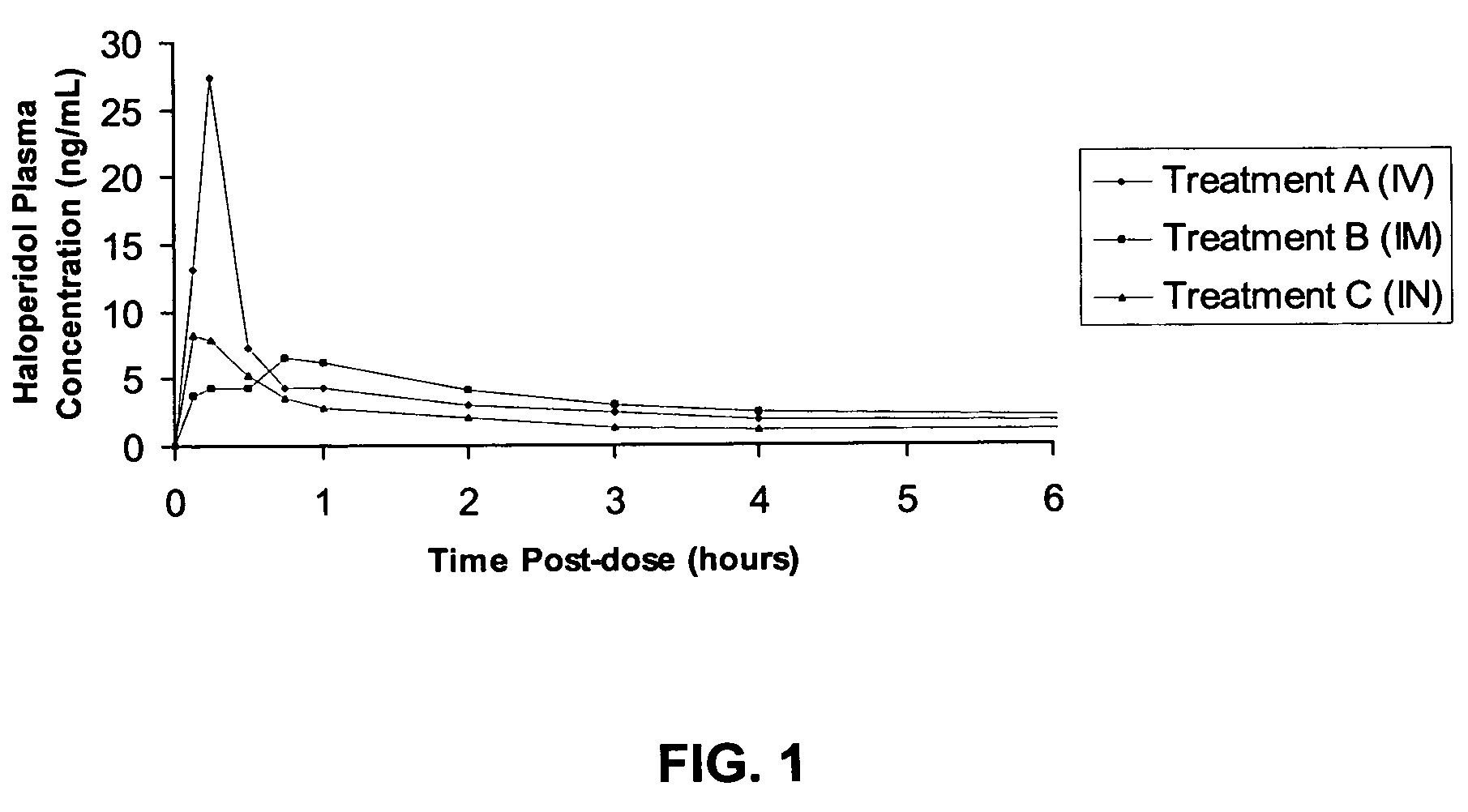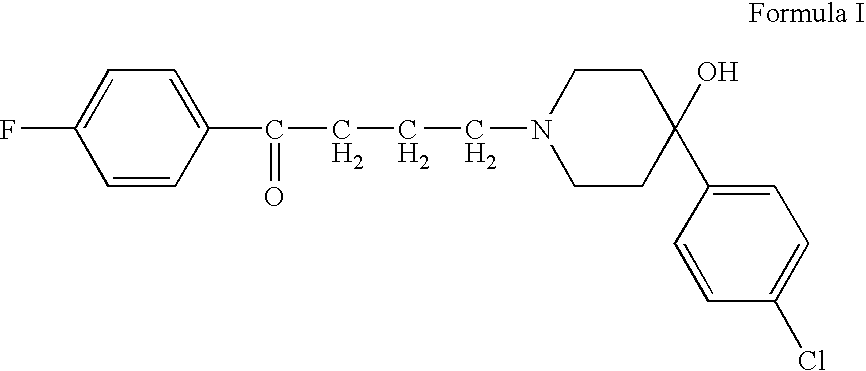Intranasal delivery of antipsychotic drugs
a technology of intranasal delivery and antipsychotics, which is applied in the field of intranasal delivery of antipsychotics, can solve the problems of increasing the sense of being attacked, the insufficient psychological and behavioral methods of obtaining control, and the patient already in a psychotic state, so as to avoid the hepatic first-pass metabolism and facilitate the systemic availability
- Summary
- Abstract
- Description
- Claims
- Application Information
AI Technical Summary
Benefits of technology
Problems solved by technology
Method used
Image
Examples
example 1
Haloperidol Intranasal Formulation—25 mg / mL
[0035] An intranasal drug product containing haloperidol is manufactured according to the following protocol. 1.18 grams of 85% USP lactic acid is added to approximately 50 g water for injection, USP and mixed. 2.5 grams of haloperidol is slowly added to the lactic acid solution while mixing until the haloperidol is completely dissolved. The solution is then brought to a volume of 100 mL, and is then filtered (22μ) and autoclaved. The solution then is dispensed in appropriate amounts into an intranasal metered dose sprayer to deliver a desired dose of haloperidol, such as 100 μL (2.5 mg). For any metered dose sprayer, such as that of International Patent Publication WO 02 / 13886, the amount dispensed is that dosage amount plus a residual volume of solution that cannot be dispensed by the delivery device.
example 2
Antipsychotic Formulations
[0036] Additional intranasal formulations may be prepared as follows. Table B provides suitable ranges for these additional products.
TABLE Badditional antipsychotic compounds and ranges.ConcentrationRange for DrugDosage rangeDrug substanceProduct (mg / mL)(per dose)ExcipientHaloperidol10 to 100 0.5 mg to 100 mgLactic acidRisperidone* 1 to 2000.1 to 20Olanzapine*50 to 200 5 to 20
*In a mildly acidic aqueous system or a non-aqueous system
[0037] Additional ingredients may be added to the formulations described above, including, sweeteners, flavors, colorings, buffers, salts, chelating agents, preservatives, and viscosity modifiers.
example 3
Bioavailability Study Comparing Intranasal, Intramuscular and Intravenous Administration of Haloperidol Lactate
[0038] The following compares the bioavailability of 2.5 mg haloperidol delivered intranasally, intramuscularly and intravenously. The intranasal dosage form is described in Examples 1 and 2, above. One spray containing 2.5 mg haloperidol in 100 μL was administered to one nostril for each patient. The intramuscular dose was given as a single injection of 0.5 mL of a 5.0 mg / mL solution of haloperidol lactate (Haloperidol Injection (5.0 mg / mL) by Ortho-McNeil). The intravenous dose was prepared by diluting 0.5 mL of a 5.0 mg / mL solution of haloperidol lactate in D5W (5% dextrose in water) and was infused over 15 minutes.
[0039] The pharmacokinetic results of the study are as follows. The mean (n=4; 2 male, 2 female) plasma concentration versus time curve profiles over the first 4 hours is shown in FIG. 1. This FIGURE shows that absorption of haloperidol following intranasal ...
PUM
| Property | Measurement | Unit |
|---|---|---|
| Fraction | aaaaa | aaaaa |
| Mass | aaaaa | aaaaa |
| Mass | aaaaa | aaaaa |
Abstract
Description
Claims
Application Information
 Login to View More
Login to View More - R&D Engineer
- R&D Manager
- IP Professional
- Industry Leading Data Capabilities
- Powerful AI technology
- Patent DNA Extraction
Browse by: Latest US Patents, China's latest patents, Technical Efficacy Thesaurus, Application Domain, Technology Topic, Popular Technical Reports.
© 2024 PatSnap. All rights reserved.Legal|Privacy policy|Modern Slavery Act Transparency Statement|Sitemap|About US| Contact US: help@patsnap.com









